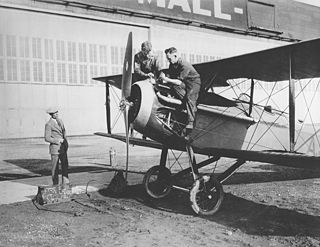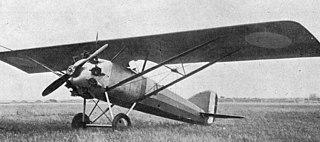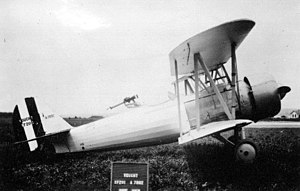
The Vought XF5U "Flying Flapjack" was an experimental U.S. Navy fighter aircraft designed by Charles H. Zimmerman for Vought during World War II. This unorthodox design consisted of a flat, somewhat disc-shaped body serving as the lifting surface. Two piston engines buried in the body drove propellers located on the leading edge, at the wingtips.

The Bell XFL Airabonita was an American experimental carrier-based interceptor aircraft developed for the United States Navy by Bell Aircraft Corporation of Buffalo, New York. It was similar to and a parallel development of the U.S. Army Air Corps’ land-based P-39 Airacobra, differing mainly in the use of a tailwheel undercarriage in place of the P-39's tricycle gear. Only one prototype was built.

The Vought XF3U was the prototype of a two-seat, all-metal biplane fighter, built by Vought Aircraft Company of Dallas, Texas for the United States Navy.

The Vought SBU-1 Corsair was a two-seat, all-metal biplane dive bomber built by Vought Aircraft Company of Dallas, Texas for the US Navy. Its design was based upon the F3U-1 two-seat fighter that was abandoned when the Navy decided not to obtain any more two-seat fighters.

The Berliner-Joyce XFJ was a United States prototype biplane fighter aircraft that first flew in May 1930. Designed by Berliner-Joyce Aircraft for the United States Navy, its lower wing, placed below the fuselage and just two feet above the ground, apparently gave it a tendency to ground loop when landing, and it was never ordered for production.

The Curtiss F7C Seahawk was a carrier-capable biplane fighter aircraft of the United States Navy Marine Corps in the late 1920s and early 1930s.

The Vought VE-7 "Bluebird" was an early biplane of the United States. First flying in 1917, it was designed as a two-seat trainer for the United States Army, then adopted by the United States Navy as its first fighter aircraft. In 1922, a VE-7 became the first airplane to take off from an American aircraft carrier.

The Nakajima A1N, or Navy Type 3 Carrier Fighter, was a Japanese carrier-based fighter of the late-1920s and early-1930s. It was a licensed copy of the British Gloster Gambet fighter, built by the Nakajima Aircraft Company for the Imperial Japanese Navy. Approximately 150 were built in two versions, the A1N1 and A1N2.

The Arado Ar 197 was a German World War II-era biplane, designed for naval operations for the never-completed German aircraft carrier Graf Zeppelin. Only a few prototypes were built; the project was abandoned in favour of the Messerschmitt Bf 109T and Me 155.

The Avro Type 584 Avocet was a British single-engined naval fighter prototype, designed and built by Avro. While the Avocet was not built in numbers, one of the prototypes was used as a seaplane trainer for the Royal Air Force's (RAF) High Speed Flight.

The Gloster SS.35 Gnatsnapper was a British naval biplane fighter design of the late 1920s. Two prototypes were built but the type did not enter production.

The Parnall Plover was a British single-seat naval fighter aircraft of the 1920s. Designed and built by George Parnall & Co. for use on Royal Navy aircraft carriers, it was ordered into small-scale production but after extensive evaluation, the Fairey Flycatcher was preferred for large-scale service.

The Grumman XSBF, also known by the company designation G-14, was an American biplane scout bomber developed by Grumman Aircraft for the United States Navy during the 1930s. Derived from Grumman's successful "Fifi" fighter, the aircraft was developed at a time when the biplane was giving way to the monoplane. In competition against other aircraft it proved to possess inferior performance in its intended role, and did not enter production. The sole prototype went on to serve as a liaison aircraft, as well as being used in experiments by NACA, before being destroyed in a crash in 1939.

The Gourdou-Leseurre GL.30 was a racing aircraft built in France in 1920 which formed the basis for a highly successful family of fighter aircraft based on the same design.
The Handley Page HP.14, also designated Handley Page R/200 was a prototype British naval reconnaissance aircraft of World War I, capable of operating from the decks of the Royal Navy's aircraft carriers or as a floatplane. Only three were built, the Parnall Panther being preferred.

The Levasseur PL.5 was a carrier-based fighter produced in France in the late 1920s, in response to the 1924 AMBC.2 specification issued by the Service Technique de l'Aéronautique (STAé). It was a conventional, single-bay sesquiplane that carried a crew of two in tandem, open cockpits. Like other Levasseur naval designs of the day, it incorporated several safety features in case of ditching at sea. Apart from small floats attached directly to the undersides of the lower wing, the main units of the fixed, tail-skid undercarriage could be jettisoned in flight, and the underside of the fuselage was given a boat-like shape and made watertight.

The Douglas XFD was a carrier-based biplane fighter aircraft designed for the United States Navy, and the first fighter to be built by the Douglas Aircraft Company. A victim of changing requirements, no production was undertaken.

The Northrop XFT was an American prototype fighter aircraft of the 1930s. A single engined low-winged monoplane, it was designed and built to meet a United States Navy order for an advanced carrier based fighter. It exhibited poor handling, and was rejected by the Navy, the single prototype being lost in a crash. A variant, the Northrop 3A, also was unsuccessful.
The Nakajima B3N was a prototype Japanese carrier-based torpedo-bomber aircraft of the 1930s. A single-engined biplane with a crew of three, it was unsuccessful, only two being built.

The Macchi M.41 was an Italian flying boat fighter prototype of 1927 designed and manufactured by Macchi. Its production model, the M.41bis, first flown in 1929, was in front line service from 1930 to 1938.


















